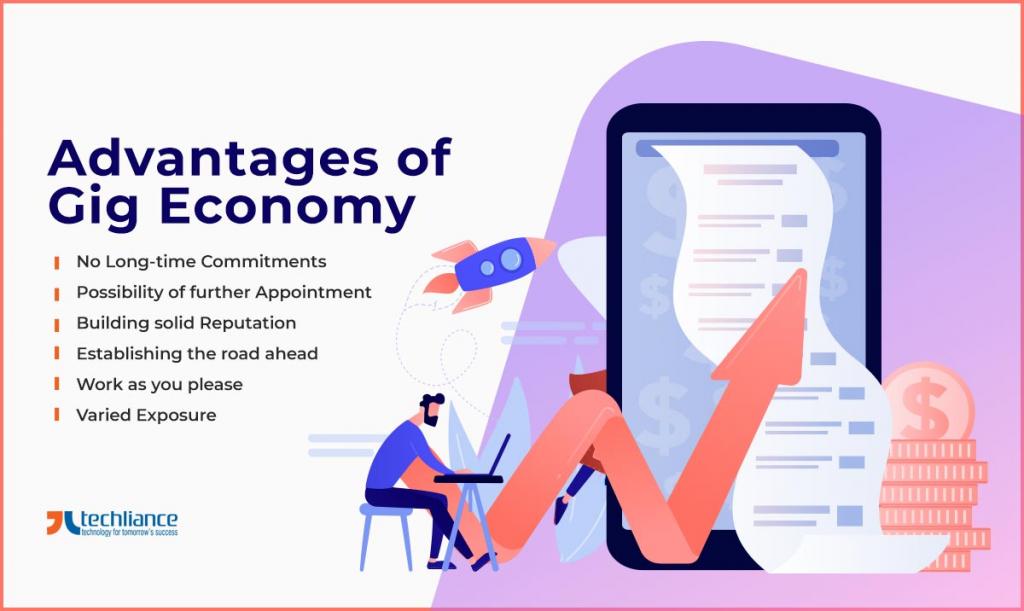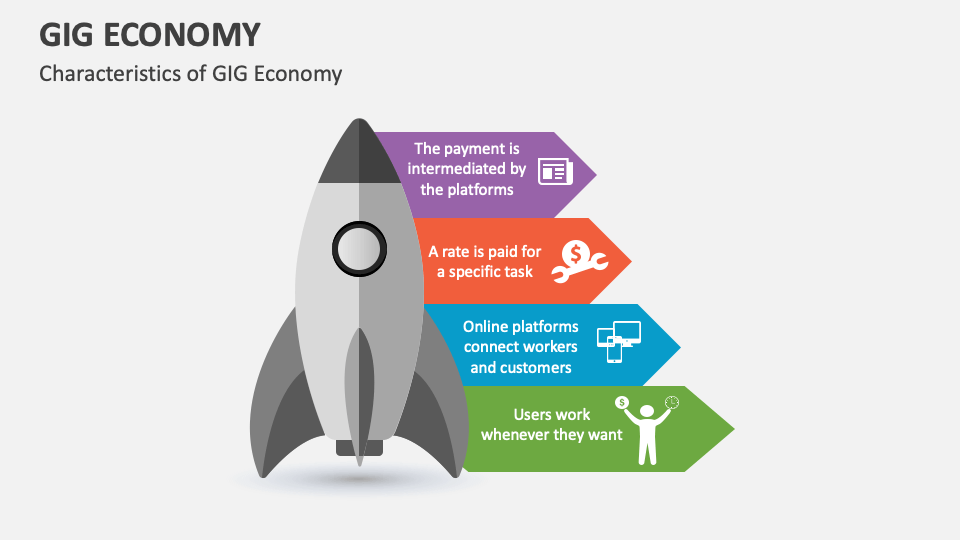Gig Economy Characteristics: A Deep Dive Into The World Of Freelancing
Picture this: You wake up in the morning, grab your coffee, and decide what you want to work on today. No boss hovering over you, no fixed 9-to-5 schedule, just pure flexibility. This, my friend, is the gig economy—a world where people trade time and skills for money without the constraints of traditional employment. Gig economy characteristics are reshaping how we think about work, careers, and financial stability.
The gig economy has become a buzzword in recent years, and for good reason. It’s not just about freelancers or Uber drivers; it’s about redefining the very concept of work. In fact, according to a study by Intuit, a whopping 43% of the U.S. workforce could be working in the gig economy by 2027. That’s a lot of people! So, whether you’re considering jumping into the gig economy or just curious about how it works, understanding its characteristics is essential.
But here’s the deal: The gig economy isn’t all sunshine and rainbows. While it offers flexibility and independence, it also comes with challenges like job insecurity and lack of benefits. So, let’s dive deeper into the gig economy characteristics, explore how they affect workers, and figure out if this new wave of work is right for you.
Read also:Noelleleyva Onlyfans The Ultimate Guide To Her Content Journey And Success
What Exactly is the Gig Economy?
Before we get into the nitty-gritty of gig economy characteristics, let’s clarify what the gig economy actually is. Simply put, the gig economy refers to a labor market where short-term contracts, freelance work, and independent contracting dominate instead of traditional full-time jobs. Think of platforms like Upwork, Fiverr, and TaskRabbit—they’re all part of this growing phenomenon.
Now, the gig economy isn’t something new. Back in the day, musicians, artists, and even plumbers worked on a gig-by-gig basis. But with the rise of technology and digital platforms, the gig economy has exploded in size and scope. From graphic designers to virtual assistants, almost every skill you can think of can now be monetized in the gig economy.
Key Characteristics of the Gig Economy
1. Flexibility – The Ultimate Selling Point
Flexibility is one of the most attractive gig economy characteristics. Unlike traditional jobs where you’re tied to a desk from 9 to 5, gig workers have the freedom to choose when, where, and how much they work. Want to take a month off to travel? Go for it! Need to work late nights to meet a deadline? No problem.
This flexibility is a double-edged sword, though. While it gives workers control over their schedules, it also means they have to be disciplined and self-motivated. Without a boss to keep you on track, it’s easy to fall into the trap of procrastination or burnout.
2. Independence – Be Your Own Boss
Independence is another major characteristic of the gig economy. Gig workers are their own bosses. They decide which projects to take on, how much to charge, and how to manage their workload. This level of autonomy is a dream come true for many people who crave freedom in their careers.
- You set your own rates.
- You choose your clients.
- You work on projects that align with your interests.
However, being your own boss also means you’re responsible for everything—from marketing yourself to handling taxes. It’s not all fun and games!
Read also:Dress To Impress Crystal Couture Your Ultimate Guide To Sparkling Elegance
Gig Economy Characteristics: The Numbers Don’t Lie
Let’s talk numbers. According to a report by McKinsey, there are approximately 162 million people in Europe and the United States who participate in the gig economy. That’s about 20-30% of the working-age population. And these numbers are only going to grow as more people embrace the gig lifestyle.
But why is the gig economy growing so rapidly? One reason is the rise of digital platforms that make it easier for workers and clients to connect. Another reason is the changing nature of work itself. With more companies adopting remote work and flexible hiring practices, the gig economy has become an attractive option for both employers and employees.
3. Short-Term Contracts – The Norm in the Gig Economy
Short-term contracts are a defining characteristic of the gig economy. Unlike traditional jobs where you sign a long-term employment contract, gig workers typically work on a project-by-project basis. This means you might work with one client for a week, another for a month, and so on.
This flexibility is great for people who like variety in their work. However, it can also lead to job insecurity. Gig workers often don’t have the same job protections as traditional employees, which can be a major concern.
Financial Aspects of the Gig Economy
4. Income Fluctuation – The Rollercoaster of Gig Work
One of the biggest challenges of the gig economy is income fluctuation. Unlike traditional jobs where you get a steady paycheck every month, gig workers’ incomes can vary widely from month to month. Some months you might earn a ton, while other months you might struggle to make ends meet.
That’s why financial planning is crucial in the gig economy. Gig workers need to be savvy with their money, saving for lean times and investing in their future. It’s not just about earning money; it’s about managing it wisely.
5. Lack of Benefits – The Hidden Cost of Gig Work
Another downside of the gig economy is the lack of benefits. Traditional employees often enjoy perks like health insurance, paid vacation days, and retirement plans. Gig workers, on the other hand, have to fend for themselves when it comes to these benefits.
This lack of benefits can be a major drawback, especially for workers who rely on healthcare or other essential services. That’s why many gig workers are calling for reforms to ensure they have access to the same benefits as traditional employees.
Social and Cultural Impacts of the Gig Economy
6. Diverse Workforce – Breaking Down Barriers
The gig economy is breaking down barriers in the workforce. People from all walks of life can now participate in the gig economy, regardless of their location, age, or background. Whether you’re a stay-at-home parent, a recent college grad, or a retiree, there’s a gig for you.
This diversity is one of the most exciting gig economy characteristics. It’s creating opportunities for people who might have been excluded from traditional employment in the past.
7. Changing Work Culture – The Future of Work
The gig economy is also changing the culture of work. As more people embrace gig work, companies are adapting by offering more flexible work arrangements. This shift is redefining what it means to have a career in the 21st century.
But this change isn’t without its challenges. The gig economy raises important questions about worker rights, job security, and the future of employment. As society evolves, we’ll need to find ways to balance flexibility with fairness.
Gig Economy Characteristics: The Pros and Cons
8. Pros – Why People Love the Gig Economy
Let’s talk about the pros of the gig economy. For many people, the gig economy offers a level of freedom and flexibility that traditional jobs just can’t match. Here are some of the top benefits:
- Flexibility in scheduling.
- Independence and autonomy.
- Opportunities to work on diverse projects.
- Potential for higher earnings.
These benefits make the gig economy an attractive option for people who value freedom and variety in their work.
9. Cons – The Challenges of Gig Work
But let’s not sugarcoat it. The gig economy isn’t all rainbows and unicorns. There are some significant challenges that gig workers face, including:
- Income instability.
- Lack of benefits.
- Job insecurity.
- Higher taxes and administrative burdens.
These challenges highlight the need for better protections and support systems for gig workers.
The Future of the Gig Economy
10. Where is the Gig Economy Heading?
The gig economy is here to stay, and it’s only going to grow in the coming years. As technology continues to evolve, we’ll see even more platforms and tools that make it easier for gig workers to connect with clients. But the big question is: How can we ensure that the gig economy works for everyone?
Some experts predict that the gig economy will lead to a new era of work where traditional employment becomes the exception rather than the norm. Others worry about the potential for exploitation and inequality. Only time will tell how the gig economy will shape the future of work.
Conclusion: Is the Gig Economy Right for You?
So, there you have it—the gig economy characteristics in a nutshell. Whether you’re already a part of the gig economy or just considering it, understanding its pros and cons is essential. The gig economy offers incredible opportunities for flexibility, independence, and financial growth, but it also comes with its share of challenges.
Before you jump into the gig economy, ask yourself: Am I ready for the ups and downs of gig work? Do I have the skills and resources to succeed? And most importantly, am I willing to take on the responsibilities that come with being my own boss?
If you answered yes to these questions, then the gig economy might just be the perfect fit for you. But remember, success in the gig economy requires hard work, dedication, and a willingness to adapt. So, what are you waiting for? Dive in and see where the gig economy takes you!
And hey, if you found this article helpful, don’t forget to share it with your friends and leave a comment below. Let’s keep the conversation going and help others navigate the world of gig work!
Table of Contents
- What Exactly is the Gig Economy?
- Key Characteristics of the Gig Economy
- Flexibility – The Ultimate Selling Point
- Independence – Be Your Own Boss
- Gig Economy Characteristics: The Numbers Don’t Lie
- Short-Term Contracts – The Norm in the Gig Economy
- Financial Aspects of the Gig Economy
- Income Fluctuation – The Rollercoaster of Gig Work
- Lack of Benefits – The Hidden Cost of Gig Work
- Social and Cultural Impacts of the Gig Economy
- Diverse Workforce – Breaking Down Barriers
- Changing Work Culture – The Future of Work
- Gig Economy Characteristics: The Pros and Cons
- The Future of the Gig Economy
- Conclusion: Is the Gig Economy Right for You?



